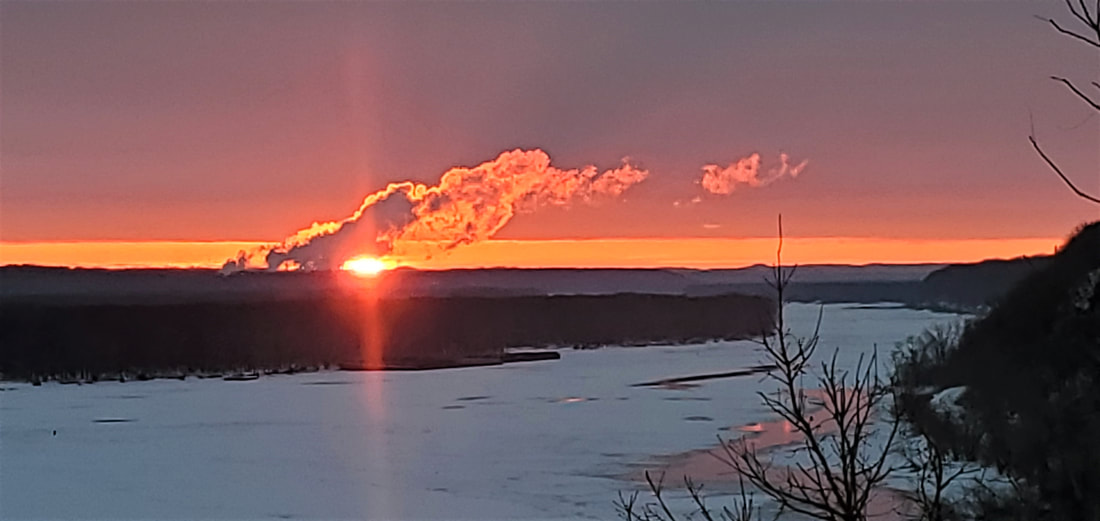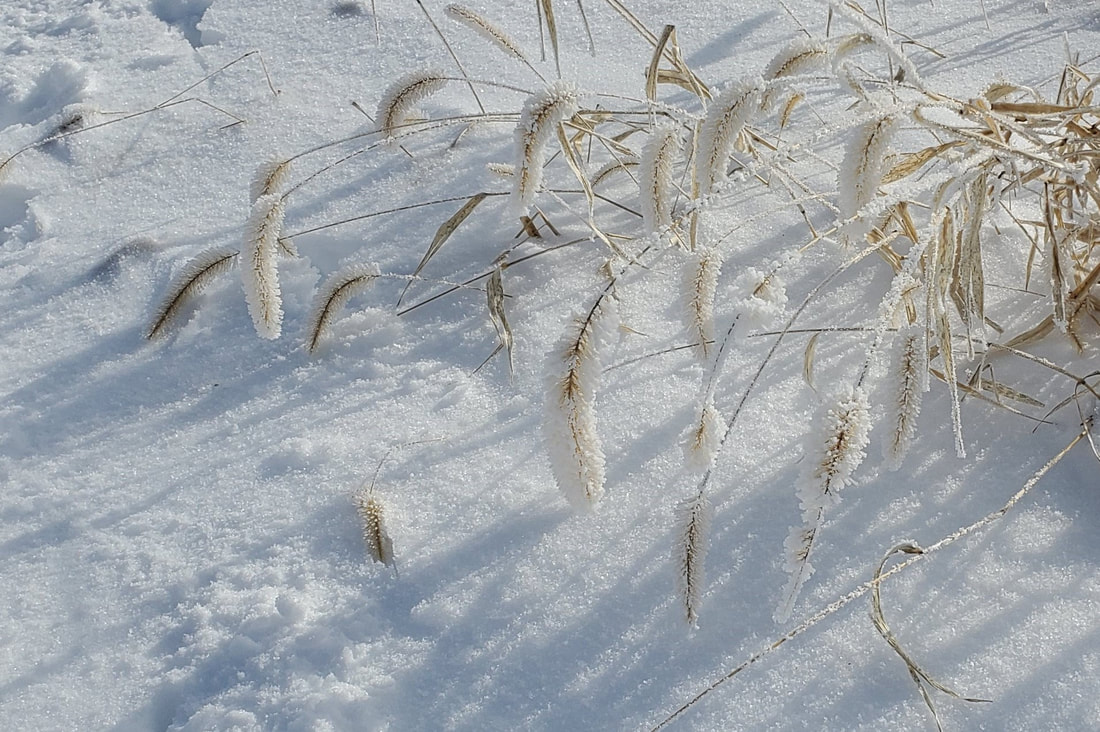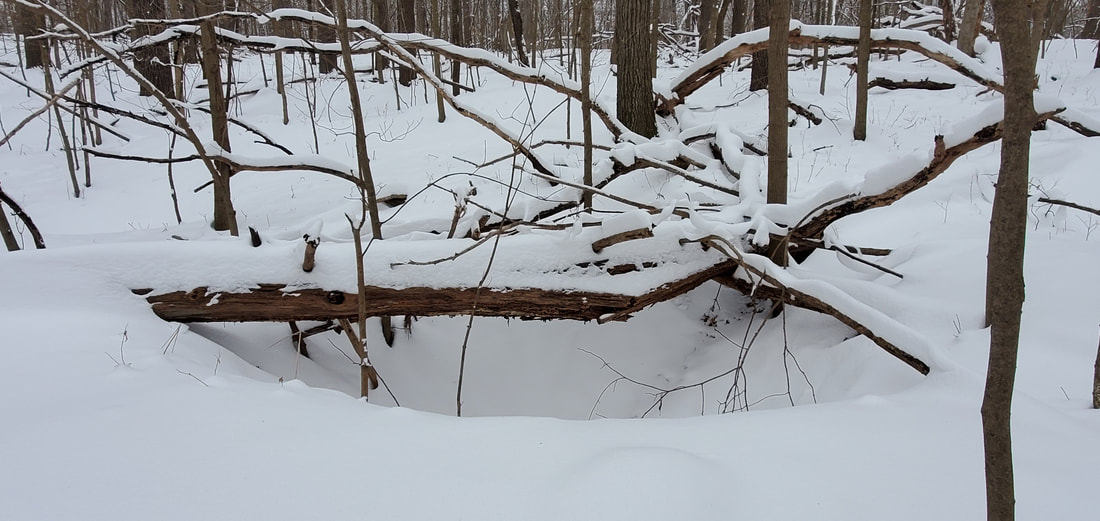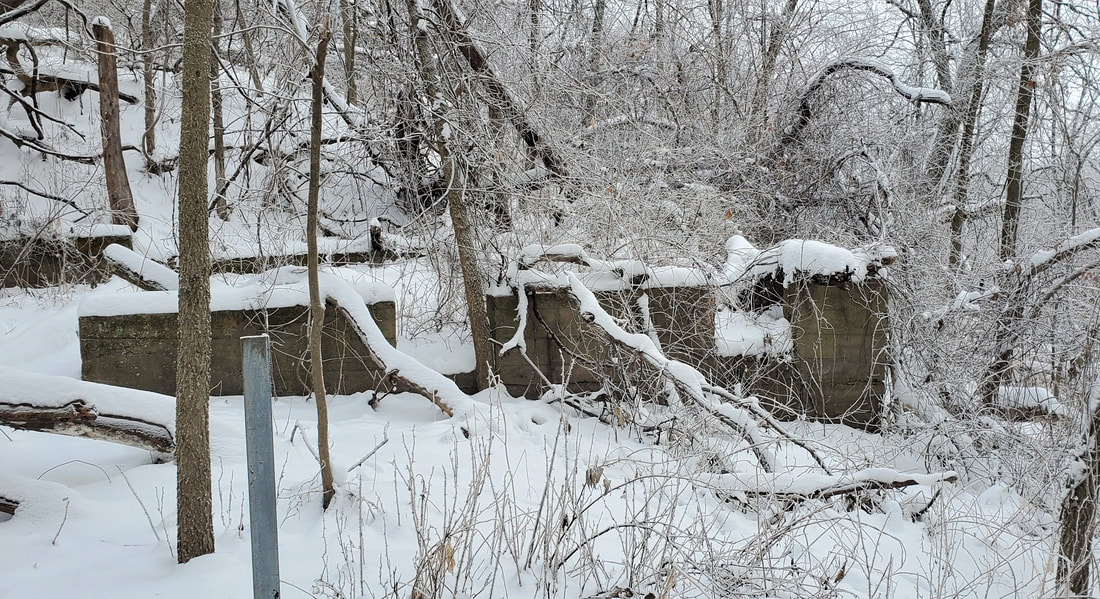The Mines of Spain is a 1400-acre State Recreation Area on the southern edge of Dubuque, featuring wooded bluffs overlooking the Mississippi River, upland prairies, wetlands, and other habitats. A National Historic Landmark, it retains the name given it by Julien Dubuque when he received permission from the Spanish Governor in Louisiana to mine lead in 1796, after previously receiving permission from the Meskwaki.
I took to another kind of digging in my recent solo treks. Mine was an excavation of the long story of this place.
Nature unfolds daily. Along the edge of woods and prairie, last night’s winter fog has crystalized this morning in contact with the branches and smaller twigs. Known as a rime frost, the heavy coating likewise drapes and bows the grasses and browned-out wildflowers of the open plain. Mouse prints padding the snow surface must be recent as well, arriving at a spray of prairie seed still scattered at the base of their stems.
One of my paths leads me past an old farmhouse foundation that has sunk back into the wild. Maybe a century old, it was razed shortly before the Mines of Spain opened as a state property in 1981. I’m old enough to remember the farmhouse sitting near the road leading to the still-operating quarry. Today the abandoned quarry known as Horseshoe Bluff is a key attraction of the Mines of Spain, offering a 200-foot sheer downcut view through the ages of bedrock.
Inside the woods I greet a few old friends, the 150-year-old oaks I recognize from previous solo visits. These oaks date back to shortly after the end of the lead-mining period when most trees had been felled to feed ore-smelting furnaces. These had not been thick forests, but oak savannas boasting intermittent hardwoods amid a prairie floor. When mining ceased, a thicker forest overtook the bluffs, starting with these now-massive oaks but eventually closing in with scrub trees, vines and ivies. The old oaks with their lateral, outstretched branches are reminders of the savanna past.
Slightly older than the oaks are the lead mine pits now overgrown by the woods. Old lead mine pits are scattered throughout the Driftless Area, but this spot overlooking the Mississippi harbors nearly 800 hand-dug craters that dot the bluff, some as large as eight feet deep and 15 feet wide. Here I imagine 1800s-miners chipping away at the bedrock to strike at surface-level veins of lead.
On another hill I encounter Native American burial mounds arched slightly above the lay of land on a hogback ridge with steeply sloping hills on either side. These burial mounds date back to the Hopewellian period from about 500 B.C.-1200 A.D., when flourishing villages lined the length of the Upper Mississippi. Small clans would disperse in winter to maximize the hunt, but regather again in communities in spring, summer, and fall to plant, hunt, harvest, and celebrate, and to bury the dead. A few of the mounds are visible to the naked eye. Others have slumped under the weight of time.
The hills are even more ancient. Finding the best place to cross a ravine in snow shoes is more art than science, an art that I won’t claim to have mastered. Too far down into the valley, the trench is steep and treacherous. The upland start of the ravine may be gentler, but buried in a tangle of fallen trees. There’s no other human tracks in here to show me the path, but I follow the deer tracks instead, figuring they know their way through these woods.
Even this ancient landscape has been reshaped in recent times—recent, at least, in geological years. While this Driftless Area was left untouched by the glaciers, the big melt that concluded 12,000 years ago gouged a deeper valley for the Mississippi River passing alongside the Mines of Spain. With a sharper slope from the uplands to the river, rainwater and snowmelt over time carved steeper ravines and made my crossings today more challenging. With a newfound robust energy, Catfish Creek on the north side of the park cut a new, more direct path to the river, hugging the base of the bluff that is home to the Julien Dubuque Monument and grave.
The hogback ridge that beds the mounds descends gradually to the oldest layer, where weather-beaten limestone columns poke through the eroded topsoil. Now we’re back 450 million years ago, at the bottom of a shallow, equatorial sea where the shells of Ordovician sea creatures are collecting in the mud. The weight of sedimentary accumulations transforms the shells into fossils and the sea bottom into limestone.
The land uplifts, the oceans recede, the ages wear on, and I am here.
Amid the weight of the ages, my solo snowshoe trek through the woods deepens the present moment. The deliberate pace of lifting each over-sized shoe slows me down. The only sounds I hear above the sigh of wind are the crunch of my shoes in the snow and my own breath.
We all feel too solitary in these COVID-restricted times. But solitude is different from being solitary. Confronting the ages alone in these Mines of Spain woods, I am in the company of all time and all beings who have graced this patch of land.



